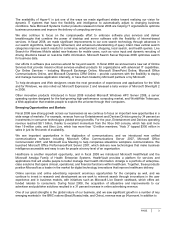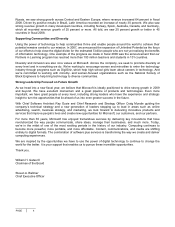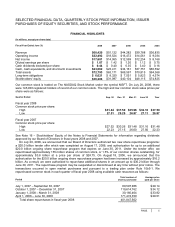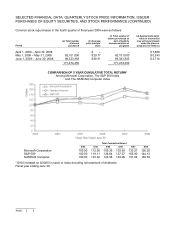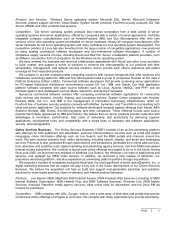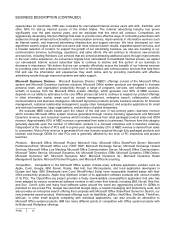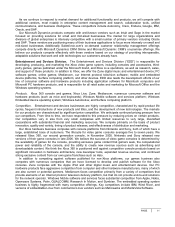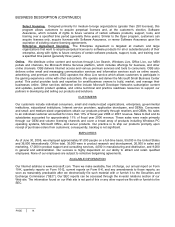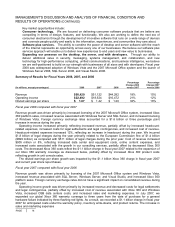Microsoft 2008 Annual Report Download - page 12
Download and view the complete annual report
Please find page 12 of the 2008 Microsoft annual report below. You can navigate through the pages in the report by either clicking on the pages listed below, or by using the keyword search tool below to find specific information within the annual report.
PAGE 11
As we continue to respond to market demand for additional functionality and products, we will compete with
additional vendors, most notably in enterprise content management and search, collaboration tools, unified
communications, and business intelligence. These competitors include Autonomy, Cisco, Endeca, Google, IBM,
Oracle, and SAP.
Our Microsoft Dynamics products compete with well-known vendors such as Intuit and Sage in the market
focused on providing solutions for small and mid-sized businesses. The market for large organizations and
divisions of global enterprises is intensely competitive with a small number of primary vendors including Oracle
and SAP. These vendors are positioning many of their business applications to focus more intensely on small and
mid-sized businesses. Additionally Salesforce.com’s on-demand customer relationship management offerings
compete directly with Microsoft Dynamics CRM Online and Microsoft Dynamic CRM’s on-premise offerings. We
believe our products compete effectively with these vendors based on our strategy of providing interoperable,
adaptable solutions that work well with technologies our customers already have.
Entertainment and Devices Division. The Entertainment and Devices Division (“EDD”) is responsible for
developing, producing, and marketing the Xbox video game system, including consoles and accessories, third-
party games, games published under the Microsoft brand, and Xbox Live operations, as well as research, sales,
and support of those products. In addition to Xbox, we offer the Zune digital music and entertainment device; PC
software games; online games; Mediaroom, our Internet protocol television software; mobile and embedded
device platforms, Surface computing platform; and other devices. EDD also leads the development efforts of our
line of consumer software and hardware products including application software for Macintosh computers and
Microsoft PC hardware products, and is responsible for all retail sales and marketing for Microsoft Office and the
Windows operating systems.
Products. Xbox 360 console and games; Xbox Live; Zune; Mediaroom; numerous consumer software and
hardware products (such as mice and keyboards); Windows Mobile software and services platform; Windows
Embedded device operating system; Windows Automotive; and Surface computing platform.
Competition. Entertainment and devices businesses are highly competitive, characterized by rapid product life
cycles, frequent introductions of new products and titles, and the development of new technologies. The markets
for our products are characterized by significant price competition. We anticipate continued pricing pressure from
our competitors. From time to time, we have responded to this pressure by reducing prices on certain products.
Our competitors vary in size from very small companies with limited resources to very large, diversified
corporations with substantial financial and marketing resources. We compete primarily on the basis of product
innovation, quality and variety, timing of product releases, and effectiveness of distribution and marketing.
Our Xbox hardware business competes with console platforms from Nintendo and Sony, both of which have a
large, established base of customers. The lifecycle for video game consoles averages five to seven years. We
released Xbox 360, our second generation console, in November 2005. Nintendo and Sony released new
versions of their game consoles in late 2006. We believe the success of video game consoles is determined by
the availability of games for the console, providing exclusive game content that gamers seek, the computational
power and reliability of the console, and the ability to create new revenue sources such as advertising and
downloadable content. We think the Xbox 360 is positioned well against competitive console products based on
significant innovation in hardware architecture, new developer tools, expanded revenue sources, and continued
strong exclusive content from our own game franchises such as Halo.
In addition to competing against software published for non-Xbox platforms, our games business also
competes with numerous companies that we have licensed to develop and publish software for the Xbox
consoles. Zune competes with the Apple iPod and other digital music and entertainment devices. Our PC
hardware products face aggressive competition from computer and other hardware manufacturers, many of which
are also current or potential partners. Mediaroom faces competition primarily from a variety of competitors that
provide elements of an Internet protocol television delivery platform, but that do not provide end-to-end solutions
for the network operator. Windows Mobile software and services faces substantial competition from Apple, Nokia,
Openwave Systems, Palm, QUALCOMM, Research In Motion, and Symbian. The embedded operating system
business is highly fragmented with many competitive offerings. Key competitors include IBM, Wind River, and
versions of embeddable Linux from commercial Linux vendors such as Metrowerks and MontaVista Software.




